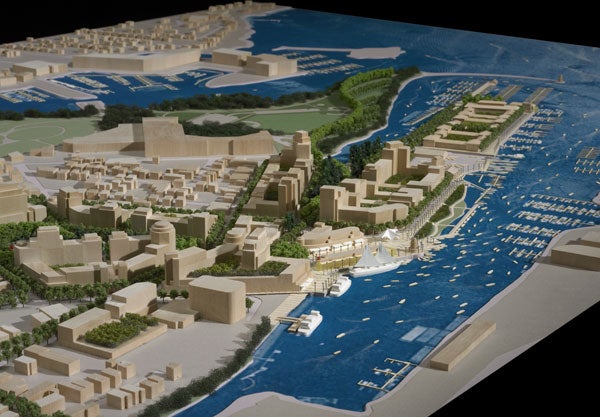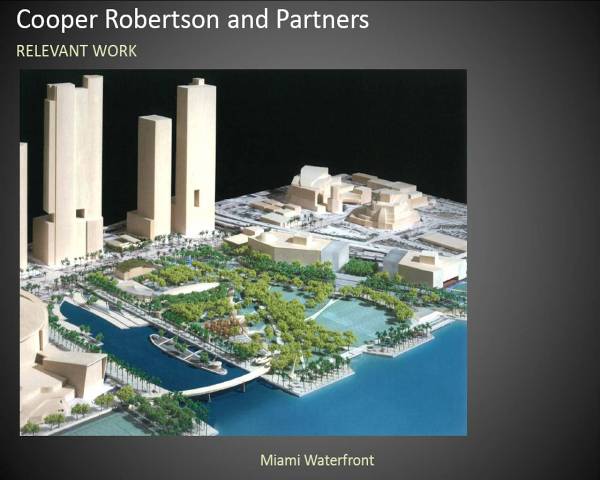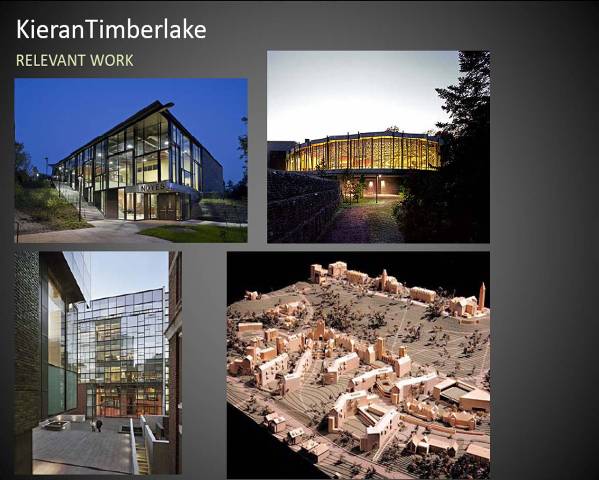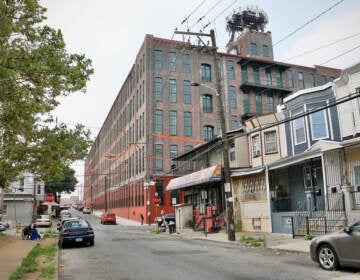Cooper, Robertson & Partners team to plan Central Delaware
Nov. 23
By Kellie Patrick Gates
For PlanPhilly
A team led by Cooper, Robertson & Partners will craft the long-term plan that will guide redevelopment of Philadelphia’s Central Delaware Waterfront.
The Delaware River Waterfront Corporation Board unanimously approved the lead firm and three others which will work on the project – OLIN and KieranTimberlake and HR&A Advisors – at its Monday meeting.
The Central Delaware Master Plan, funded with a $1 million grant from the William Penn Foundation, is expected to take at least 12 more months to complete. It will take decades to fully implement.

Cooper, Robertson project: Battery Park City
https://www.youtube.com/watch?v=-DTnMXVKVCI
Cooper, a New York firm led by Alexander Cooper, was chosen in part for its body of work, which includes Battery Park in New York, said planning committee chairwoman Marilyn Jordan Taylor, who is Dean of the Penn School of Design.

Cooper, Robertson project: Harbor Point/Stamford
“Because of the challenges of so many post-industrial sites and the difficulties of a weak market, we wanted a team that had strong balance between design, urban design, landscape design, public realm design, and how to make it happen in the market,” she said after the meeting.
Other factors were also important as Taylor’s committee whittled the 23 applicants to five finalists, and then made its choice: The other firms in relevant disciplines that the main applicant assembled to help it complete the project, the full team’s ability to help ensure the plan is properly codified in zoning and other laws, the amount of time the firms’ top guns would devote to the riverfront plan.
https://www.youtube.com/watch?v=dGPJNT0J_6k
But perhaps most important was how well the group would work together and with the DRWC – and how persuasive they could be in selling the eventual plan to the public, riverfront property owners and developers, and would-be funders.
“It’s not the firm or firms. It’s not the project or projects that they’ve done. It’s really the chemistry of the key individuals, and the leadership qualities of the key individuals,” Taylor said. She elaborated on this during an interview after the meeting. “These are people who can be persuasive to potential developers, potential investors … about the importance of public access, about the relationship of the public and the private, about why there is a master plan that may put certain form-based expectations on their development, rather than just leaving them free to do anything they want.
“There may be view considerations, may be open space considerations, may be sustainability considerations or the sense of environment we’d like to feel at the waters edge that would sort of impinge on an unfettered property right.”
https://www.youtube.com/watch?v=pNtqtbUWMBY
All five finalists said this project would likely be the most challenging they’ve ever done, Taylor said, in part because the 7-mile swath of waterfront from Allegheny Ave. to Oregon Ave. is so large, and more than 95 percent of it is in private hands.
It’s the details of how the eventual master plan will impact private property that brought Craig Schelter – former chair of the city’s planning commission and executive director of the non-profit Development Workshop – to the meeting. He was the only member of the public who attended. Schelter said that because of the high percentage of privately owned waterfront parcels, economic advisors HR&A should be as integral to the master plan process as the planners, architects and landscape architects. Taylor assured him this was the case.
https://www.youtube.com/watch?v=CmVBxuvQ0WE
Two documents which will likely have a major impact on the plan are the Civic Vision for the Central Delaware Waterfront – put together by PennPraxis, at the city’s request, after more than a year of public input – and a zoning overlay that calls for a 100-foot waterfront setback wherever possible.
Schelter has said in previous interviews that the setback is problematic because it amounts to a public taking of private land.
Taylor said Monday that she is hopeful the riverfront can be developed without paying for private land. Rather, she hopes a good plan will show developers that a revitalized waterfront is beneficial to them as well. She said that land owners and developers will be included in the Master Plan process. They will be instrumental in helping to determine where dense development will go, she said – adding quickly that only some of the waterfront will be developed densely. “We’re not thinking about a rush to Center City density along this river,” she said. “But there are some places where you can expect that,” such as near Penn’s Landing.
https://www.youtube.com/watch?v=UQyrA_KfNv4
The DRWC hosted a public, “meet the finalists” forum earlier this month. Participants did not have a direct say in which firm was selected, Taylor said, but the planning committee considered the written comments they submitted as it winnowed the short-list down to one.
“The two teams that actually became our finalists in the selection committee’s deliberation were the two that were most frequently mentioned by comments – especially the written comments from the audience – as bringing the talents that were needed,” Taylor said.
She did not reveal the runner-up.
Because William Penn is funding the Master Plan, they have to approve the team selection, and have verbally done so.
Taylor’s committee will spend December negotiating with the chosen team on the scope of work expected and other contract details. The Cooper/OLIN/KieranTimberlake/HR&A team will get started on the plan in January.
While it will take upwards of 30 years to fully realize the plan, work will begin on some key areas much sooner than that. In fact, a temporary multi-use trail, while not officially open yet, has been mostly completed. The Race Street Pier – formerly known as Pier 11 – is expected to open as a public park in summer 2011, and preliminary work on Pier 53 is expected to begin soon.
Other than that, expect to see early projects concentrated on “points of strong connection to the city, points where people are already at the water, and points with some form of transit connection,” Taylor said. “It’s pretty logical to look at this plan and think ‘Spring Garden and the Festival Pier site – the old incinerator site.’”
But other ideas that have come up in the process so far have been more surprising, Taylor said. “Instead of thinking of Big Box retail as an obstruction to active use of the waterfront – Walmart and the other things there are really a big attractor,” she said. So maybe there is a way to better capitalize on that, she said.
ON THE WEB: Previous coverage
Contact the reporter at kelliespatrick@gmail.com
WHYY is your source for fact-based, in-depth journalism and information. As a nonprofit organization, we rely on financial support from readers like you. Please give today.












